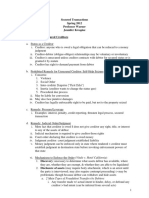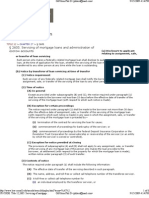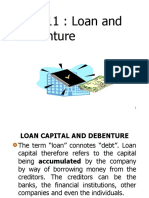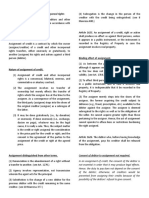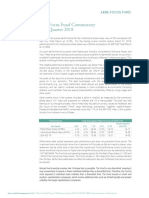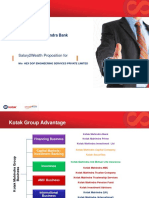Scan 0005
Scan 0005
Uploaded by
El Sayed AbdelgawwadCopyright:
Available Formats
Scan 0005
Scan 0005
Uploaded by
El Sayed AbdelgawwadOriginal Description:
Copyright
Available Formats
Share this document
Did you find this document useful?
Is this content inappropriate?
Copyright:
Available Formats
Scan 0005
Scan 0005
Uploaded by
El Sayed AbdelgawwadCopyright:
Available Formats
240 MODULE27 BANKRUPTCY
b. Trustee, with court approval, may employ professionals (e.g., accountants and lawyers) to assist'
trustee in carrying out duties that require professional expertise
(1) Employed professional must not hold any interest adverse to that of debtor (i.e., to avoid con-
flicts of interest)
(2) Employed professional has right to receive compensation for reasonable value of services per-
formed .
(a) Reasonable fee is based on amount and complexity of services rendered, not on size of es-
tate
(3) Trustee, with court approval, may act in professional capacity if capable and be compensated
separately for professional services rendered .
c. Trustee must within sixty days of the order for relief assume or reject any executory contract, in-
cluding leases, made by the debtor
(1) Any not assumed are deemed rejected
(2) Trustee must perform all obligations on lease of nonresidential property until lease is either as-
sumed ~r rejected
(3) Rejection of a contract is a breach of contract and injured party may become an unsecured
creditor
(4) Trustee may assign or retain leases if good for bankrupt's estate and if allowed under lease
and state law
(5) Rejection or assumption of lease is subject to court approval
d. Trustee may set aside liens (those which arise automatically under law) if lien
(1) Becomes effective when bankruptcy petition is filed or when debtor becomes insolvent
(2) Is not enforceable against a bona fide purchaser when the petition is filed
(3) In the case of a security interest, is not perfected before filing of bankruptcy petition
e. Trustee may set aside transfers made within one year prior to the filing of the bankruptcy peti-
tion if
(1) The transfer was made with intent to hinder, delay, or defraud any creditor. The debtor need
not be insolvent at time of transfer.
(2) Debtor received less than a reasonably equivalent value in exchange for such transfer or ob-
ligation and the debtor
(a) Was insolvent at the time, or became insolvent as a result of the transfer
(b) If the fact that the transfer was a fraudulent conveyance was the only grounds for avoiding
the transfer; once avoided by trustee, transferee that .gave value in good faith
has a lien on
property transferred to the extent of value given
f. Trustee may also set aside preferential transfers of nonexempt property to a creditor made within
the previous ninety days while insolvent in the "bankruptcy sense"
(1) Preferential transfers are those made for antecedent debts that enable the creditor to receive
more than s/he would have otherwise under a Chapter 7 liquidation proceeding
(a) Includes a security interest given by debtor to secure antecedent debt
EXAMPLE: Debtor paid off a loan to BB Bank sixty days before Debtor filed a bankruptcy petition. This
is a preferential transfer.
EXAMPLE: Debtor gave CC Bank a security interest in some office furniture he owns to secure a
previous loan CC Bank had granted him. This is a preferential transfer if Debtor gave the security
interest within ninety days of the filing of bankruptcy. The reason for this is that it gives the creditor
(bank) greater rights than it had before.
EXAMPLE: Debtor prepaid some installments on an installment loan on equipment.
EXAMPLE: Debtor made a gift to charity. This is not a transfer for an antecedent debt.
(2) Preferential transfers made to insiders within the previous twelve months may be set aside
( ontrolling stockholders of corpora-
a tions, or general partners of partnerships
)
I EXAMPLE: S is a secured creditor of XYZ Co. that is in Chapter 7 bankruptcy. S is not an insider.
n
s
i
d
e
r
s
a
r
e
c
l
o
s
e
b
l
o
o
d
r
e
l
a
t
i
v
e
s
,
o
f
f
i
c
e
r
s
,
d
i
r
e
c
t
o
r
s
,
c
You might also like
- Blackstone and The Sale of Citigroup's Loan PortfolioDocument10 pagesBlackstone and The Sale of Citigroup's Loan PortfolioRonak Jain0% (1)
- Stock StatementDocument4 pagesStock Statementgovindbhai73% (22)
- Credit Transactions Essay 2013Document18 pagesCredit Transactions Essay 2013huhah303No ratings yet
- SecuredTransactions OutlineDocument70 pagesSecuredTransactions OutlineCarolina Jordan100% (1)
- Secured Transaction OutlineDocument43 pagesSecured Transaction Outlinecjd223100% (6)
- The Big Short Movie AnalysisDocument8 pagesThe Big Short Movie AnalysisMoses MachariaNo ratings yet
- Business Entities Fall 2010Document75 pagesBusiness Entities Fall 2010David Yergee100% (1)
- Scan 0006Document2 pagesScan 0006El Sayed AbdelgawwadNo ratings yet
- Buckley Secured Transactions Spring 2010Document90 pagesBuckley Secured Transactions Spring 2010tspencer28No ratings yet
- Company Law and Secreterial Practice-IIDocument31 pagesCompany Law and Secreterial Practice-IIraghavsairam39No ratings yet
- B Kruptcy: E Chapter 1 Bankruptc ProceedingDocument2 pagesB Kruptcy: E Chapter 1 Bankruptc ProceedingZeyad El-sayedNo ratings yet
- Zambia Institute of Advanced Legal Education - Suggested Model Answers - 2018Document25 pagesZambia Institute of Advanced Legal Education - Suggested Model Answers - 2018Leonard TemboNo ratings yet
- Creditors' Rights and Bankruptcy: W C I ADocument21 pagesCreditors' Rights and Bankruptcy: W C I AHolli Boyd-White100% (1)
- Secured Transaction OutlineDocument21 pagesSecured Transaction OutlineSavana DegroatNo ratings yet
- Review Material Secured Transactions Fall Semester 2021Document13 pagesReview Material Secured Transactions Fall Semester 2021OlavoNo ratings yet
- Hongkong and Shanghai Banking Corporation: Power Plant Mall, Lopez DR, Makati, 1210 Metro ManilaDocument4 pagesHongkong and Shanghai Banking Corporation: Power Plant Mall, Lopez DR, Makati, 1210 Metro ManilaMarichu Castillo HernandezNo ratings yet
- DebentureDocument5 pagesDebentureShweta RawatNo ratings yet
- Banruptcy Notes IntroductionDocument3 pagesBanruptcy Notes IntroductionkennedyNo ratings yet
- Mode of Charging of SecurityDocument13 pagesMode of Charging of SecurityAbhijit SahaNo ratings yet
- Prop B ExamDocument38 pagesProp B Examowqje ojqwe ojqNo ratings yet
- US CODE Title 12-2605 (F) (3) Damages and CostsDocument6 pagesUS CODE Title 12-2605 (F) (3) Damages and CostsPhilNo ratings yet
- Scan 0007Document2 pagesScan 0007El-Sayed MohammedNo ratings yet
- Loan and AdvancesDocument11 pagesLoan and AdvanceswubeNo ratings yet
- Secured Transactions OutlineDocument22 pagesSecured Transactions Outlinetroberp100% (4)
- Exam Prep May June 2017Document24 pagesExam Prep May June 2017thabang macheleNo ratings yet
- Topic 11-Loan DebentureDocument57 pagesTopic 11-Loan DebentureSofia ArissaNo ratings yet
- 1705081337867_1705080644707_LENDING AND ADVANCESDocument49 pages1705081337867_1705080644707_LENDING AND ADVANCESkatiassteven00No ratings yet
- Enforcement of Security Interest Secured Creditor'S Rights: Group 5 Credit TransactionDocument22 pagesEnforcement of Security Interest Secured Creditor'S Rights: Group 5 Credit Transactionmc_abelaNo ratings yet
- Acc 108 Current LiabilitiesDocument5 pagesAcc 108 Current Liabilitiesmkrisnaharq99No ratings yet
- Letters of Credit and Trust Receipt LawDocument9 pagesLetters of Credit and Trust Receipt LawJovi PlatzNo ratings yet
- Fall 2017 Security InterestDocument89 pagesFall 2017 Security InterestSarah EunJu LeeNo ratings yet
- Mortgages Outline 4-9-23Document3 pagesMortgages Outline 4-9-23Arjen MeterNo ratings yet
- Good One On R - L MortgagorDocument21 pagesGood One On R - L MortgagorYash ToshniwalNo ratings yet
- Study Guide Law On Credit TransactionsDocument5 pagesStudy Guide Law On Credit TransactionsCamille ArominNo ratings yet
- فقط موادDocument16 pagesفقط موادdemi6kNo ratings yet
- Lecture On BankrupctyDocument36 pagesLecture On BankrupctyRakib HossainNo ratings yet
- Bankruptcy Outline1Document45 pagesBankruptcy Outline1Nicmarie1809No ratings yet
- Gould Real Estate Finance Winter 2010 Final OutlineDocument82 pagesGould Real Estate Finance Winter 2010 Final OutlinesznitzelNo ratings yet
- Summary LA CTDocument60 pagesSummary LA CTNhorylyn Braza BordonadoNo ratings yet
- Bsci Bsst111 Su4 PCDocument32 pagesBsci Bsst111 Su4 PCndzamelasinoNo ratings yet
- Corporate and Company AccountsDocument58 pagesCorporate and Company Accountsdhiyarj10No ratings yet
- Study Unit 10 - PCDocument26 pagesStudy Unit 10 - PCEl Sean YoungSet Nba IINo ratings yet
- Property LawDocument15 pagesProperty LawaryanNo ratings yet
- B Nkruptcy: Discharge of A BankruptDocument2 pagesB Nkruptcy: Discharge of A BankruptZeyad El-sayedNo ratings yet
- Scan 0007Document2 pagesScan 0007El Sayed AbdelgawwadNo ratings yet
- Financial Rehabilitation and Insolvency Act of 2010 2Document22 pagesFinancial Rehabilitation and Insolvency Act of 2010 2Hanna Mae CatudayNo ratings yet
- DEBENTURESDocument9 pagesDEBENTURESKajal RaiNo ratings yet
- Extinguishment of ObligationDocument17 pagesExtinguishment of ObligationAngelieNo ratings yet
- Law On Sales Chapter 8Document4 pagesLaw On Sales Chapter 8Edith Dalida100% (1)
- Up - Law - Boc - Civil - Law (2) - 468Document1 pageUp - Law - Boc - Civil - Law (2) - 468trishamaecahutay123No ratings yet
- Personal Property Security Act Outline StudentDocument10 pagesPersonal Property Security Act Outline StudentJosiah Balgos100% (1)
- BANKRUPTCY AND LIQUIDATION Class NotesDocument25 pagesBANKRUPTCY AND LIQUIDATION Class NotesitulejamesNo ratings yet
- DebenturesDocument6 pagesDebenturesSenelwa AnayaNo ratings yet
- Duties, Powers and Rights of Trustees in WA 1. What Legislation Governs The Affairs of A Trustee?Document3 pagesDuties, Powers and Rights of Trustees in WA 1. What Legislation Governs The Affairs of A Trustee?Prakash kumarNo ratings yet
- Chapter-2 Issue of Debentures BY: G Arun Kumar Mcom Mba Net Asst Professor in Commerce GDC Men SrikakulamDocument39 pagesChapter-2 Issue of Debentures BY: G Arun Kumar Mcom Mba Net Asst Professor in Commerce GDC Men SrikakulamgeddadaarunNo ratings yet
- Quotation - Divorce - Ho Pei AikDocument2 pagesQuotation - Divorce - Ho Pei Aikg24pwkm2ryNo ratings yet
- Bank Lending - A Look at The Standard Provisions of A Facility Agreement and General Considerations Corporate LoansDocument47 pagesBank Lending - A Look at The Standard Provisions of A Facility Agreement and General Considerations Corporate Loanssrinath.koten1962No ratings yet
- debtorinpossession-financingDocument7 pagesdebtorinpossession-financingAidan HolwerdaNo ratings yet
- Oblicon - FEBRUARY 2, 2022Document4 pagesOblicon - FEBRUARY 2, 2022Alona JeanNo ratings yet
- Deduction From The Gross EstateDocument5 pagesDeduction From The Gross Estaterorrory683No ratings yet
- Convertible Loan Agreement Template: How To Use This TemplateDocument11 pagesConvertible Loan Agreement Template: How To Use This TemplateGaos FakhryNo ratings yet
- Reverse Mortgage: Leverage Home Equity, the Appraised Value, and Asset-Backed SecuritiesFrom EverandReverse Mortgage: Leverage Home Equity, the Appraised Value, and Asset-Backed SecuritiesNo ratings yet
- Securitized Real Estate and 1031 ExchangesFrom EverandSecuritized Real Estate and 1031 ExchangesNo ratings yet
- Understanding Named, Automatic and Additional Insureds in the CGL PolicyFrom EverandUnderstanding Named, Automatic and Additional Insureds in the CGL PolicyNo ratings yet
- Agency: I. Formation of The Agency RelationshipDocument7 pagesAgency: I. Formation of The Agency RelationshipEl Sayed AbdelgawwadNo ratings yet
- M Dule 22 Federal Securities Acts and Antitrust LawDocument2 pagesM Dule 22 Federal Securities Acts and Antitrust LawEl Sayed AbdelgawwadNo ratings yet
- Module 22 Federal Securities Acts and Antitrust LawDocument2 pagesModule 22 Federal Securities Acts and Antitrust LawEl Sayed AbdelgawwadNo ratings yet
- Federal Securities Acts and Antitrust Law: C o C eDocument2 pagesFederal Securities Acts and Antitrust Law: C o C eEl Sayed AbdelgawwadNo ratings yet
- Module 22 Federal Securities Acts and Antitrust LawDocument2 pagesModule 22 Federal Securities Acts and Antitrust LawEl Sayed AbdelgawwadNo ratings yet
- P L N L U N N T MP: Sarbanes-Ox Eyactof2 2Document2 pagesP L N L U N N T MP: Sarbanes-Ox Eyactof2 2El Sayed AbdelgawwadNo ratings yet
- Federal Securities Acts and Antitrust LawDocument3 pagesFederal Securities Acts and Antitrust LawEl Sayed AbdelgawwadNo ratings yet
- Scan 0015Document2 pagesScan 0015El Sayed AbdelgawwadNo ratings yet
- Scan 0020Document2 pagesScan 0020El Sayed AbdelgawwadNo ratings yet
- C Ayton Act of 1914: Module 22 Fe E A SE UDocument2 pagesC Ayton Act of 1914: Module 22 Fe E A SE UEl Sayed AbdelgawwadNo ratings yet
- Cont Acts: G A A yDocument1 pageCont Acts: G A A yEl Sayed AbdelgawwadNo ratings yet
- Scan 0014Document2 pagesScan 0014El Sayed AbdelgawwadNo ratings yet
- J .T/DTD: Tjrrji?"Document1 pageJ .T/DTD: Tjrrji?"El Sayed AbdelgawwadNo ratings yet
- Scan 0014Document2 pagesScan 0014El Sayed AbdelgawwadNo ratings yet
- S S S T I E: ContractsDocument2 pagesS S S T I E: ContractsEl Sayed AbdelgawwadNo ratings yet
- Scan 0021Document2 pagesScan 0021El Sayed AbdelgawwadNo ratings yet
- Cont A: R CTSDocument2 pagesCont A: R CTSEl Sayed AbdelgawwadNo ratings yet
- Scan 0014Document2 pagesScan 0014El Sayed AbdelgawwadNo ratings yet
- Scan 0002Document2 pagesScan 0002El Sayed AbdelgawwadNo ratings yet
- Module 26 Secured Transactions:: o C, G eDocument2 pagesModule 26 Secured Transactions:: o C, G eEl Sayed AbdelgawwadNo ratings yet
- Contracts: D Still Owes CTDocument2 pagesContracts: D Still Owes CTEl Sayed AbdelgawwadNo ratings yet
- Scan 0003Document2 pagesScan 0003El Sayed AbdelgawwadNo ratings yet
- Scan 0002Document2 pagesScan 0002El Sayed AbdelgawwadNo ratings yet
- Ill LLQ J: ContractsDocument2 pagesIll LLQ J: ContractsEl Sayed AbdelgawwadNo ratings yet
- Scan 0007Document2 pagesScan 0007El Sayed AbdelgawwadNo ratings yet
- Secured Transactions: FreezerDocument2 pagesSecured Transactions: FreezerEl Sayed AbdelgawwadNo ratings yet
- Fi V Y, A (A A y I R S (B) A R S Si: Secured TransactionsDocument2 pagesFi V Y, A (A A y I R S (B) A R S Si: Secured TransactionsEl Sayed AbdelgawwadNo ratings yet
- Contracts: Over IDocument2 pagesContracts: Over IEl Sayed AbdelgawwadNo ratings yet
- Module 26 Secured Transactions:: S G S C R eDocument2 pagesModule 26 Secured Transactions:: S G S C R eEl Sayed AbdelgawwadNo ratings yet
- Priorities: Secu Ed TransactionsDocument2 pagesPriorities: Secu Ed TransactionsEl Sayed AbdelgawwadNo ratings yet
- Missle Mail JUNE 8, 1959Document1 pageMissle Mail JUNE 8, 1959Dan TurnerNo ratings yet
- Engineering Management by Roberto MedinaDocument38 pagesEngineering Management by Roberto MedinaJezreel TorresNo ratings yet
- Acre Capital Management 1Q18Document2 pagesAcre Capital Management 1Q18Anonymous j5tXg7onNo ratings yet
- Structure of Indian Securities Market SEBIDocument21 pagesStructure of Indian Securities Market SEBIAJ SuriNo ratings yet
- Asset-V1 IMF+FMAx+2T2017+type@asset+block@FMAx M3 CLEAN NewDocument47 pagesAsset-V1 IMF+FMAx+2T2017+type@asset+block@FMAx M3 CLEAN NewkingjaspeNo ratings yet
- Financial Modeling Brochure - F 2021Document5 pagesFinancial Modeling Brochure - F 2021Ayush UpadhyayNo ratings yet
- General Study On "Implied Volatility"Document24 pagesGeneral Study On "Implied Volatility"Nikhil kapadiyaNo ratings yet
- Smart Investment Basket Thematic: Quick Service Restaurant (QSR)Document2 pagesSmart Investment Basket Thematic: Quick Service Restaurant (QSR)vikalp123123No ratings yet
- Suggested Answers To Bar Exam Questions 2008 On Mercantile LawDocument9 pagesSuggested Answers To Bar Exam Questions 2008 On Mercantile LawsevenfivefiveNo ratings yet
- Syntel 10kDocument143 pagesSyntel 10kTara MontoyaNo ratings yet
- Problem Set 1Document3 pagesProblem Set 1thighbone2003No ratings yet
- Tran Tan Phat - s3878775 - Financial Instrumens and Technologies Assessment 1Document10 pagesTran Tan Phat - s3878775 - Financial Instrumens and Technologies Assessment 1s3878775No ratings yet
- Bard-Parker Company, Inc. v. Commissioner of Internal Revenue, 218 F.2d 52, 2d Cir. (1955)Document8 pagesBard-Parker Company, Inc. v. Commissioner of Internal Revenue, 218 F.2d 52, 2d Cir. (1955)Scribd Government DocsNo ratings yet
- Underwriting and Lead Management (TCM)Document8 pagesUnderwriting and Lead Management (TCM)Monalisa BagdeNo ratings yet
- Development of The Vietnam Derivative Stock Market: Nguyen Tuan AnhDocument7 pagesDevelopment of The Vietnam Derivative Stock Market: Nguyen Tuan AnhHồng ÁnhNo ratings yet
- UFCW LM-2 2008 Labor Organization Annual ReportDocument279 pagesUFCW LM-2 2008 Labor Organization Annual ReportUnion MonitorNo ratings yet
- Business Finance - Final ExamDocument3 pagesBusiness Finance - Final ExamRain Vicente100% (1)
- Accounts Project IFRSDocument27 pagesAccounts Project IFRSShivam SenNo ratings yet
- Profit and LossDocument16 pagesProfit and LossjohnnyNo ratings yet
- Week 3Document60 pagesWeek 3AJNo ratings yet
- Scheme of Arrangement Between Just Dial Limited and Just Dial Global Private Limited and Their Respective Shareholders and Creditors (Corp. Action)Document3 pagesScheme of Arrangement Between Just Dial Limited and Just Dial Global Private Limited and Their Respective Shareholders and Creditors (Corp. Action)Shyam SunderNo ratings yet
- Salary2Wealth PropositionDocument30 pagesSalary2Wealth Propositionpavan kumarNo ratings yet
- Capital StructureDocument28 pagesCapital StructureDipinderNo ratings yet
- TUI Annual Report 2018Document276 pagesTUI Annual Report 2018chiaraNo ratings yet
- Special Counsel For Carey Ebert, As Trustee For Latitude Solutions, IncDocument94 pagesSpecial Counsel For Carey Ebert, As Trustee For Latitude Solutions, IncLakisha Schwartz100% (1)
- Final Project Sip Mutual FundsDocument74 pagesFinal Project Sip Mutual FundsMallesh ArjaNo ratings yet



